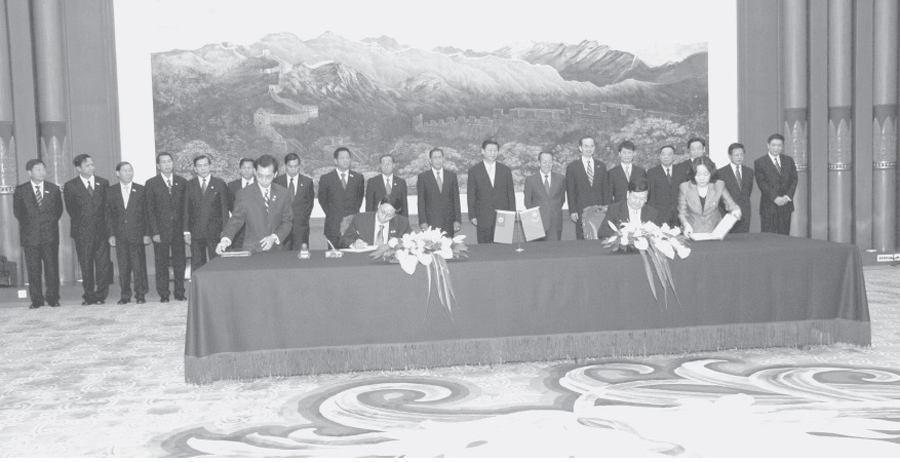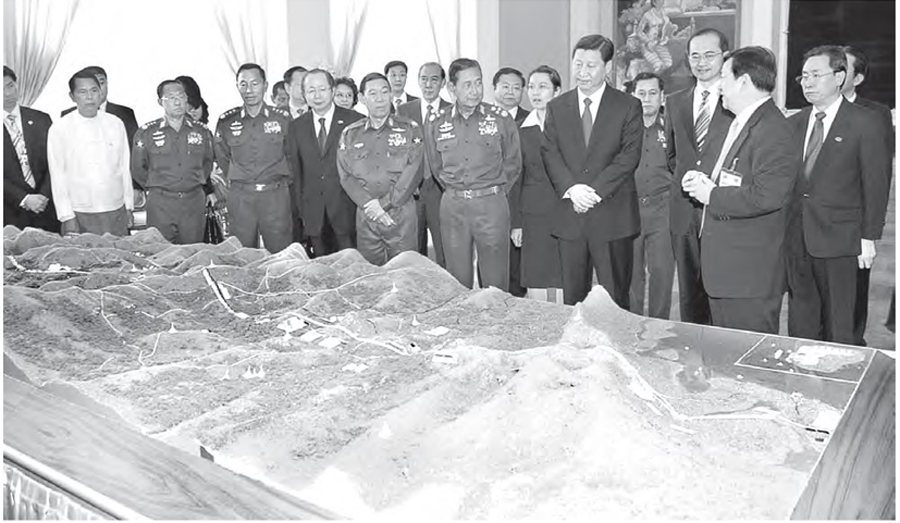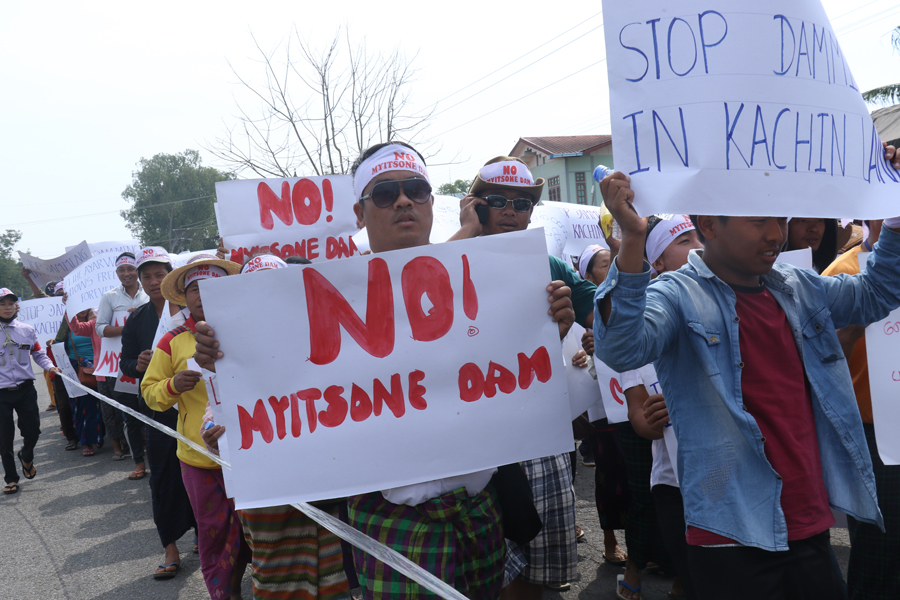YANGON—Had its original construction schedule not been derailed by controversy and public condemnation, leading to its suspension in 2011, the Chinese-backed Myitsone Dam hydropower project near the source of the Irrawaddy River in Kachin State would be operational by now as scheduled.
It has been eight years since the suspension. Currently, the project site on the bank of the river is mostly deserted. When it was launched on Dec. 21, 2009, the Myanmar Investment Commission estimated total investment in Myitsone Dam would amount to US$4.3 billion (6.54 trillion kyats). The project was in the middle of construction when it was halted in September 2011. Before the suspension, resettlement at the dam site was finished, and site formation, water supply, electricity and transportation facilities had commenced, according to its Chinese developer, State Power Investment Corporation (SPIC), which was known as China Power Investment (CPI) until 2015.
Despite recent pressure from China to resume the dam’s construction, anti-dam sentiment is still on the rise among the public. Recently, prominent civil society leaders, environmentalists, writers and artists announced that they would launch a one-dollar campaign to collect money from the public to compensate China in exchange for scrapping the project. The campaign clearly reflects how unpopular the project is among Myanmar people. They don’t like it because the project near the confluence of the Maykha and Malikha rivers, which gives rise to the Irrawaddy River, would destroy the country’s lifeline waterway, which runs through the country from north to south before emptying into the Andaman Sea. For Myanmar people, the river is the source of their identity because the Irrawaddy valley is the cradle of Myanmar civilization. Furthermore, they fear the dam would disrupt the flow of sediment along river, harming agricultural livelihoods. Plus, the dam site is reportedly seismically unstable; a collapse would have the potential to flood an area twice the size of Singapore.
It’s interesting to note how such a controversial mega project came into existence. The following is a brief flashback summarizing the development of the Myitsone Dam issue and identifying those involved in the project’s inception at a time when Myanmar was under military rule.
Beginnings
It all started with the Ministry of Electrical Power’s hydropower project master plan for the upstream Irrawaddy River basin in Kachin State in late 2005. The plan was initially developed with Yunnan Machinery (Equipment) Export & Import Company (YMEC) and Kunming Hydropower Institute of Design. The plan was scrapped when the ministry was reformed in May of the following year as the Ministry of Electric Power-1 (MOEP-1) for generating electrical power and the Ministry of Electric Power-2 for distribution.
Enter the CPI
On Oct. 29, 2006, Myanmar’s then prime minister, the late General Soe Win, left for Nanning, the capital of Guangxi autonomous region in southern China. The visit came three years after he oversaw the bloody attack on then opposition leader Daw Aung San Suu Kyi’s motorcade in Depayin in upper Myanmar in May 2003, shortly before he assumed the prime minister position. The purpose of the China trip was to attend the Third China-Asean Exposition (CAEXPO) and Summit. Among those he met during a series of meetings in Nanning were officials from China Power Investment (CPI). On Oct. 31, the prime minister officially invited CPI on behalf of the Myanmar government to invest in and develop hydropower projects along major rivers including the Irrawaddy and the Chindwin. After careful consideration, the CPI decided to accept the Myanmar government’s invitation to develop hydropower projects in the upstream Irrawaddy River basin, according to the Chinese company.

Two months later, on Dec. 28, a CPI delegation led by its vice president, Shi Chengliang, arrived at the office of Electric Power-1 Minister Colonel Zaw Min in Naypyitaw. Among them was CPI’s local partner, U.S. sanctions-listed Stephen Law, aka U Htun Myint Naing, managing director of Asia World Company (AWC). He is the son of the late drug lord Lo Hsing Han. The purpose of the visit was to sign a memorandum of understanding (MoU) between MOEP-1 and CPI for the Maykha-Malikha Water Resources Development and Ayeyawaddy (Irrawaddy) Confluence Hydropower Project. Hydro Power Implementation Department director general U Aung Koe Shwe and the vice president of CPI’s Department of Planning and Development, Wang Xian Chun, signed the MoU and exchanged documents. State-run newspapers at the time reported that the department and CPI would build a 2,000-MW hydropower project at Chipwe on the Maykha River and a 3,600-MW project near the confluence of the two rivers that form the Irrawaddy River.
Eight Projects
On April 30, 2007, a groundbreaking ceremony for another project, the 65MW Chipwe Nge hydropower project, was held. According to the government’s announcement, the project aimed to provide electricity for seven other projects slated for the Maykha and Malikha rivers near Myitsone. The ceremony was attended by CPI vice president Shi and then Northern Command chief Lieutenant-General Ohn Myint, AWC’s Htun Myint Naing and others. In 2011, when military junta chief Snr-Gen. Than Shwe ceded power to a quasi-civilian government led by his subordinates, U Ohn Myint became minister for livestock, fisheries and rural development. As minister he was widely known by his nickname “Slapping Ohn Myint” for a physical threat to the public he made during his tenure, saying, “I can go around and slap anyone’s face… if they insult or oppose the government.”
A few days later on May 6, a site management office for the Myitsone and Chipwe projects opened in the Kachin State capital, Myitkyina.
Environmental Impact Assessment
According to International Rivers, CPI funded and commissioned China’s Changjiang Institute of Survey, Planning, Design and Research (CISPDR) to conduct the Environmental Impact Assessment (EIA) with Myanmar experts from the Biodiversity and Nature Conservation Association (BANCA) in the project areas. On Dec. 24, 2008, BANCA and CPI signed an agreement to conduct an EIA.
From January to July 2009, Myanmar and Chinese experts conducted the study on the upper Irrawaddy. The report was finalized in October of that year, but BANCA chairman Dr. Htin Hla said BANCA’s environmental baseline assessment report and the broader EIA could not be regarded as a perfect observation document because the study was forced to conclude within five months instead of seven due to time constraints faced by the Chinese experts.
CPI did not wait for the EIA to be finalized before commencing construction and resettlement. Construction began in December 2009, three months before the final EIA was reportedly made available to CPI from CISPDR in March 2010. International Rivers said parts of the EIA are contradictory to BANCA’s findings.
MoA Signed in China
In March 2009, the Myanmar and Chinese governments reached a framework agreement on hydropower cooperation. According to CPI’s Myanmar subsidiary Upstream Ayeyawaddy Confluence Basin Hydropower Co., Ltd (ACHC), both parties expressly supported the CPI’s investment and development in the projects.

Myitsone Project Launched
In December 2009, the Myanmar government, CPI Yunnan International Power Investment Co., Ltd. (CPIYN) and Asia World Co., Ltd. entered a joint venture agreement (JVA) on the development of Myitsone Dam Project or Myitsone Hydropower Project. Officials of the two states witnessed the signing of major agreements.

Right after Xi’s visit, on the next day, Dec. 21, the Myitsone Dam project was launched at the project site, 4.3 miles downstream of the Irrawaddy confluence. Northern Commander Major-General Soe Win, MOEP-1 Minister Colonel Zaw Min, CPI President Lu Qizhou, Yunnan Province Vice Governor Zong Hua and others were present.

ACHC, a joint venture established by the Ministry of Electricity and Energy (MOEE), SPIC Yunnan International Power Investment Co., Ltd. (SPICYN) and Asia World Company (AWC), was registered in Naypyitaw on June 18, 2010. According to ACHC, the shareholding ratio between MOEE, SPICYN and AWC is 15, 80 and 5 percent, respectively.
Apart from Myitsone Dam on the Irrawaddy River, the company plans to construct seven other hydropower dam projects: Chipwi, Wutsok, Hpizaw, Kawnglanghpu, Renam and Chipwi Nge on the upper reaches of the Maykha River, and Laza on the Malikha River. The total planned installation capacity is about 21,600 MW with a total investment of more than $25 billion.
Out of the slated eight projects, only Chipwi Nge has been completed so far and is generating electricity. Most of the rest are in the initial stages and suspended due to public criticism as well as armed conflicts between local ethnic armed groups and government troops in their areas.

Criticism and Suspension
On January 24, 2011, then Prime Minister U Thein Sein visited the Myitsone Dam site to inspect the progress of the dam, which was 8.5 percent complete. From its inception, the project had been never been popular among local Kachin. The following month saw anti-dam sentiment spread across the country and abroad.
To counter the criticism, the MOEP-1 minister, ex-Col. Zaw Min—under the pseudonyms “Staff Member of MEPE” and “Kyaw Min Lu”—penned two articles on Aug. 9 and 10 in state-run newspapers, saying, “I wish they would view the Myitsone Dam reasonably.”
The next day, Aug. 11, an appeal letter from then opposition leader Daw Aung San Suu Kyi urging that the Irrawaddy River be spared kicked the anti-dam movement into high gear. Writing in a private capacity, she asked that more thought and study be put into the project before authorities proceeded with it.
“While recognizing that large sums of money have already been spent on the realization of the project, we would urge that in the interests of both national and international harmony, concerned parties should reassess the scheme and cooperate to find solutions that would prevent undesirable consequences and thus allay the fears of all who are anxious to protect the Irrawaddy,” Daw Aung San Suu Kyi said.
Exactly one month later, in September, the minister told the media during a press conference that the Myitsone Dam project “wouldn’t be given up for all the criticism” because it was needed for electricity.
When asked about the dam’s negative impact on the environment and residents, the one-time colonel retorted: “We need to think which is bigger, the damage to the environment or benefits to our country. We are implementing this project because the benefits are bigger than the anticipated damage to the environment.”
On Sept. 17, the Myanmar government hosted a workshop in Naypyitaw to discuss the impact of hydropower projects on the Irrawaddy River, with ministers, NGOs and Chinese investment interests represented. The workshop turned into heated argument as the attendees differed on the pros and cons of the project.
At the workshop, Minister for Industry-1 and Industry-2 ex-vice admiral Soe Thane, who was also Myanmar’s Industrial Development Committee chairman and President U Thein Sein’s aide at the time, favored other upstream dam projects over Myitsone.
He later wrote in “Myanmar’s Transformation & U Thein Sein: An Insider Account” that he had known that instead of Myitsone, U Thein Sein preferred other hydropower projects upstream, and was in favor of replacing Myitsone’s 6,000 MW with projects totaling 4,000 MW, thereby reducing the area to be flooded.
On Sept. 30, President Thein Sein announced the suspension of the Myitsone Dam “in the time of our government”, citing the adverse ecological consequences, hydrological risks, the displacement of up to 20,000 people, and the loss of their livelihoods. However, he said later, other dams upstream would continue, as Myanmar was “not failing to honor what one friend should do for another.”

The suspension announcement caught China off guard. CPI President Lu Qizhou told China Daily that the Myanmar side never communicated with them in any way about the suspension. Lu said the president’s decision was “very bewildering” because U Thein Sein himself had urged CPI to accelerate work on the dam when he inspected it in January as the military’s then prime minister. He warned that a complete halt to construction would “lead to a series of legal issues” because the two countries had already secured loans to pay for $20 billion worth of hydropower projects in Kachin State.
However, Beijing’s recent efforts to revive the dam have fueled negative sentiment among the Myanmar public. Daw Aung San Suu Kyi’s government hasn’t made public its view on whether the dam should be resumed or terminated. But recent remarks by the State Counselor suggesting that governments ought to respect the deals made by their predecessors have raised public concerns that the dam project is back on track.
Unfulfilled Promise
While on the campaign trail on Oct. 2, 2015 in Myitkyina, Kachin State, Daw Aung San Suu Kyi told prospective voters that the first thing the NLD would do if it was elected would be to make public the deal between the government and the Chinese firm on the dam. Now, after more than three years in office, her government has yet to publish the contract.
Instead, she formed a 20-member commission tasked with evaluating hydropower projects on the Irrawaddy River on Aug. 12, 2016. The commission has produced two reports to date, but the government has yet to make either of them public.
After a few years in the wilderness, the Myitsone Dam issue sparked public concerns again this year after Chinese Ambassador Hong Liang’s claim, following a visit to Kachin State in late December in 2018, that the Kachin people were not opposed to the dam’s resumption. It prompted a series of protests in major cities calling for the project to be scrapped. On the other hand, Daw Aung San Suu Kyi’s government hasn’t made public its view on whether the dam should be resumed or terminated.

Adding to the public’s concerns, the State Counselor suggested in Pyay on March 14 that governments ought to respect the deals made by their predecessors, causing worries that the dam project is back on track.
When Daw Aung San Suu Kyi left for Beijing on April 24 to attend the 2nd Belt and Road Summit, many at home believed that Myitsone would be on the agenda during her meeting with Chinese President Xi Jinping on the same day.

However, Myanmar President’s Office spokesperson U Zaw Htay told The Irrawaddy on April 26 that the issue was not discussed during the trip.
“We won’t do any secret dealings [about the dam]. There will be transparency and we will let the public know how we will deal with it,” he said.

















